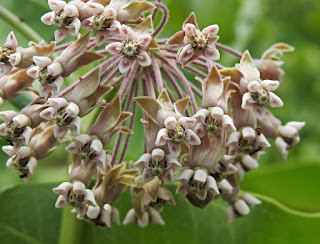To respond by e-mail, please address
your message to the information line editor, nelsonpoirier435@gmail.com .
Please advise the editor at nelsonpoirier435@gmail.com if any
errors are noted in wording or photo labelling. Note that corrections,
deletions, or delayed additions may not always appear on the Info Line and
email transcript but will always appear on the BlogSpot. For this reason, it is
recommended that those wishing to look at historical records use the BlogSpot
rather than the email transcript. The BlogSpot can always be accessed from
the website.
Edited by: Nelson Poirier nelsonpoirier435@gmail.com
Info Line # 506-384-6397 (384-NEWS)
** Aldo Dorio took a photo of the
EASTERN TENT CATERPILLARS [Chenille de la tente orientale] with their base tent
structure in one of their favourite sites of a CHOKECHERRY bush which happens
to be in full bloom showing the cone-like flower clusters of Chokecherry vs the
pincushion style clusters of Pin Cherry. Aldo also got a photo of a CANADA
GOOSE [Bernache du Canada] family travelling in a very soldierly line with
parents posted at each end.
** I am reattaching Gordon Rattray’s
EVENING PRIMROSE [Onagre] photo as this plant does some very interesting
things. It likes to close during bright, sunny days and open in the evenings or
cloudy days due to its close association with the Primrose Moth that lives its
whole life on this plant. The adult is now flying at night, pollinating the
Primrose, and during the day often stays hidden in the closed down petals, well
camouflaged in white, pink and yellow with some similarities to the Rosy Maple
Moth but smaller. It lays its eggs and the developing larval caterpillars feed
on the primrose pods, looking so much like a pod that one has to stare at look
for them to see them as they grow at the same rate as the pods do. If you see
“frass” (caterpillar poop) on the plant then caterpillars are present. It’s one
of Mother Nature’s special relationships, pollination in exchange for a bite to
eat.
On Friday Gordon shares a photo of the
common plant ... BLADDER CAMPION [Campion de la vessie] blooming at the moment,
a nice photo of a female NORTHERN FLICKER [Pic flamboyant] (no black moustache)
peering over the grass, and a striking photo of a RIVER JEWELWING DAMSELFLY [Jewelwing
rivière]. The Jewelwings, of which we have three, are the larger damselflies that
we have. Gordon reports that 4 of the 5 Tree Swallow boxes that he has out are
occupied.
A large YELLOW UNDERWING MOTH was day
perched on his screen. This introduced European moth has become very common;
however it is very variable in its markings but the yellow underwing with a
black border is a clue to think of first. Gordon also has a critter attached to
his screen which I had no clue as to what it was. BugGuide said it was a beetle
pupa of some type and to keep it around and find out so Gordon get it in a jar
quickly and let’s find out!
** Brian Stone checked out the Gorge
Rd. MILKWEED [asclépiade] patches on Friday to find the plants looking healthy
despite the yellow leaves present at the bottom of most plants. Several of the
flower groups were open and wafting a strong, pleasant fragrance in the air
that just has to let Monarch Butterflies know it’s ready to have them drop by.
Brian took 4 of the small, individual flowers home and the little flowers were
potent enough to fill his living room with their aroma. He also spotted a
HARRIS’S CHECKERSPOT BUTTERFLY [Damier de Harris], a VICEROY BUTTERFLY
[Vice-roi], and a PECK’S SKIPPER BUTTERFLY [Hespérie de Peck] along the way. The
Viceroy Butterfly is easy to think Monarch Butterfly at first glance but the
dark bar across the hindwing, smaller size, and less white spotting at the wing
rim helps to quickly tell the difference. The Viceroy larval food plant is
willow whereas the Monarch Butterfly larval food plant is milkweed; however,
the Viceroy Butterfly will nectar milkweed flowers just to fool
naturalists!
Nelson Poirier,
Nature Moncton
EVENING PRIMROSE. JUNE 24, 2020. GORDON RATTRAY
BLADDER CAMPION. JUNE 26, 2020. GORDON RATTRAY
COMMON MILKWEED PATCH. JUNE 26, 2020. BRIAN STONE
COMMON MILKWEED FLOWER CLUSTER. JUNE 26, 2020. BRIAN STONE
VICEROY BUTTERFLY. JUNE 26, 2020.BRIAN STONE
MONARCH BUTTERFLY-LEFT....VICEROY BUTTERFLY- RIGHT (from Mr.Google))
HARRIS'S CHECKERSPOT BUTTERFLY. JUNE 26, 2020. BRIAN STONE
PECK'S SKIPPER BUTTERFLY. JUNE 26, 2020. BRIAN STONE
RIVER JEWELWING DAMSELFLY. JUNE 26, 2020. GORDON RATTRAY
RIVER JEWELWING DAMSELFLY. JUNE 26, 2020. GORDON RATTRAY
NORTHERN FLICKER (FEMALE). JUNE 26, 2020. GORDON RATTRAY
LARGE YELLOW UNDERWING MOTH. JUNE 26, 2020. GORDON RATTRAY
LARGE YELLOW UNDERWING MOTH. JUNE 26, 2020. GORDON RATTRAY
EASTERN TENT CATERPILLARS IN THEIR FAVOURED CHOKECHERRY SITE. JUNE 26, 2020. ALDO DORIO
CANADA GOOSE FAMILY. JUNE 26, 2020. ALDO DORIO
BEETLE PUPA. JUNE 26, 2020. GORDON RATTRAY
TREE SWALLOW. JUNE 26, 2020. GORDON RATTRAY
















